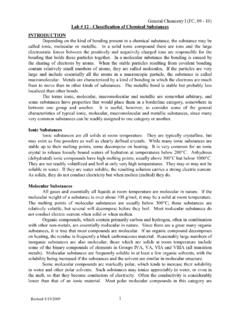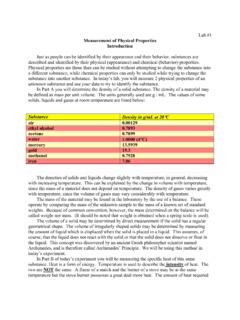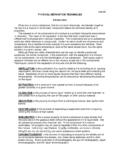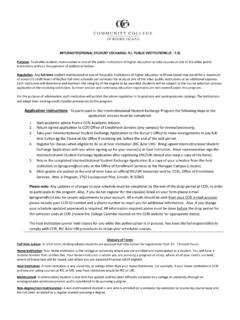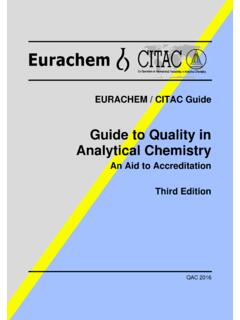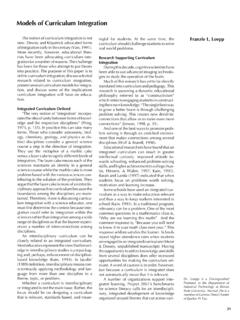Transcription of General Chemistry II Lab Experiment #9: pH: Measurement ...
1 1. General Chemistry II Lab Experiment #9: pH: Measurement and Uses Introduction One of the most important properties of aqueous solutions is the concentration of hydrogen ion. The concentration of H+1 (or H3O+1) affects the solubility of inorganic and organic species, the nature of complex metal cations and the rates of chemical reactions. For convenience the concentration of H+1 is frequently expressed as the pH of the solution rather than hydrogen ion molarity. pH is defined by the equation: pH = -log[H+1] (1).
2 Where the logarithm is taken to the base 10. If [H+1] is 1 x 10-4 moles per liter, the pH of the solution is 4. If [H+1] = 5 x 10-2 M, the pH is Basic solutions are also described in terms of pH. In water the following relation exists: [H+1] x [OH-1] = Kw = x 10-14 at 25 C (2). Since [H+1] equals [OH-1] in pure water, by Equation 2, [H+1] must be 1 x 10-7 M. Therefore, the pH of distilled water is 7. Solutions in which [H+1] > [OH-1] are acidic and will have a pH < 7. When [H+1] < [OH-1], a solution is basic and pH >7.
3 A solution with a pH of 10 will have [H+1]. = 1 x 10-10 M and a [OH-1] = 1 x 10-4 M. pH Measurement : pH can be determined experimentally in two ways. One is to use an indicator, a soluble dye whose color is sensitive to pH. Indicator colors change over a relatively short (about 2-unit) pH. range. When properly chosen, they give the approximate pH of solutions. Two common indicators are litmus, usually used on paper, and phenolphthalein, commonly used in acid-base titrations. Litmus changes from red to blue in the pH range 6 to 8.
4 Phenolphthalein changes from colorless to red in the range 8 to 10. Any one indicator is useful for determining pH only in the region where it changes color. Indicators are available for measuring pH in any part of the scale. Universal indicator papers, which contain a mixture of several indicators and change color over a wide pH range, are also in common use. An electronic pH meter is used for more precise measurements. A pH meter determines pH from the electrical potential between two electrodes in a solution.
5 The potential varies with pH and activates an analog or digital meter calibrated to read pH directly to the nearest or unit. A pH meter is used when reliable knowledge or control of pH is necessary. Weak Acids and Bases: Strong acids such as HCl and HNO3, ionize completely in solution. [H+1] in a 1M HCl solution is also 1M because there are no undissociated HCl molecules in the system. Similarly, strong bases such as NaOH, ionize completely in solution; [OH-1] is in NaOH; there are no NaOH. molecules present. Weak acids, so called because they do not dissociate completely in solution, 2.
6 Also produce acidic solutions. The General formula of a weak acid can be written as HA. In water, HA ionizes to a small extent according to the equation HA(aq) H+1(aq) + A-1(aq) (3). In M CH3 COOH, [H+1] equals about M. [CH3 COOH] is also M, [CH3 COOH]. remains about M and the pH of the solution is 3. In solutions of CH3 COOH, in contrast to those of HCl, there are many undissociated acid molecules. The species in solution will obey the law of chemical equilibrium, so that Ka = [H+1] [A-1]/ [HA] (4). The conditions imposed by Equation 4 are obeyed in any solution where some HA molecules are present.
7 Ka, the equilibrium constant for the reaction, is the dissociation constant of HA, and has a constant value at a given temperature. The species HA may be an organic acid, such as acetic acid, a hydrated metal cation, such as Cu(H2O)42+, ammonium ion, NH4+1 or an inorganic molecule or anion, like H2CO3. Acid dissociation equations for these species are: CH3 COOH CH3 COO-1 + H+1 (5). NH4+1 + H2O NH3 + H3O+1 (6). H2CO3 H+1 + HCO3-1 (7). Hydrolysis: Other substances besides those identified as acids including many metal cations, form acidic solutions through hydrolysis.
8 Metal cations, especially those having multiple positive charges and small radii, generate protons in solution from the dissociation of water molecules coordinated to the metal ion, as shown in equation (8). Cu(H2O)42+ + H2O Cu(H2O)3(OH)+1 + H3O+1 (8). Many substances in addition to NaOH form basic solutions. These materials are related in a simple way to weak acids. Consider the properties of the A-1 ion from the weak acid HA, in a solution of the salt NaA. Since HA is a weak acid, A-1 ions in solution combine with H+1 to form HA molecules.
9 In a solution of NaA, some anions undergo hydrolysis, that is, accept protons from the solvent water molecules, according to the equation: A-1(aq) + H2O OH-1(aq) + HA(aq) (9). Reaction 9 usually does not go very far, since Ka is typically very small. Even if the reaction proceeds to a small extent, excess OH-1 ions are produced and the solution becomes basic. Because of Reaction 10, A-1 ion is a weak base. As a General rule, the sodium or potassium salts of weak acids behave as weak bases. Ammonia, NH3 is a common molecular weak base.
10 NH3, in Equation 7, plays the same role as C2H3O2-1 in Equation 5. Both are analogous to the A- ion and both behave as weak bases. The reaction similar to (9) in which NH3 participates is 3. NH3(aq) + H2O NH4+1(aq) + OH-1(aq) (10). In M NH3 about 1 per cent of NH3 molecules react according to Equation 10. In that solution, [OH-1] is about M. [NH4+1] is also M. [NH3] does not decrease significantly from M. Buffers: Solutions which undergo only a small change in pH when small quantities of acid or base are added to them are called buffers.
